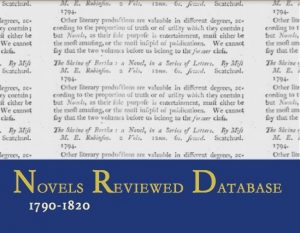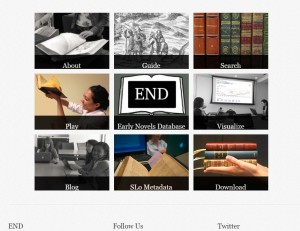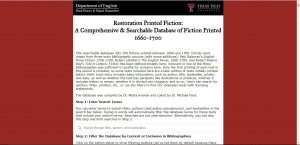
Restoration Printed Fiction
Bibliographers have done much important work on the history of the novel in the long eighteenth century. Scholars are indebted to bibliographies from McBurney’s Check List of English Prose Fiction, 1700-1739 to Beasley’s Novels of the 1740s to Raven’s British Fiction, 1750-1770 and Garside et al.’s The English Novel, 1770-1829; these works form the foundation of a great deal of scholarship. But there are some things that bibliographies cannot do. When I set out to plan a book chapter on fiction in the years 1660-1700, I found very little that could serve as a guide to help me identify which texts would be most useful and important to read. The Early Novels Database was promising, but was not then available, and in any case was focused on texts held in one particular library. So I began compiling what was at first a simple list of titles drawn from older bibliographies and gradually became a spreadsheet and then a database. As I worked on the initial list, it became clear that in order to decide what to read, I needed to know more about each text’s material and paratextual features: which texts, for instance, were fully epistolary, and which included letters in the fiction? Which texts had addresses to the reader, and which had dedications? And of course, as I began consulting EEBO scans to identify these features, other features also struck me as worthy of note: indexes, chapters, tables of contents, and so on. And as I gathered this information, it occurred to me that other scholars might be interested in a resource like this.
Thus was born the Restoration Printed Fiction database, now available online. It catalogs metadata for the 394 works of fiction published between 1660 and 1700. To generate this list of fiction, entries were drawn from three main bibliographic sources (with some additions): Paul Salzman’s English Prose Fiction 1558-1700, Robert Letellier’s The English Novel, 1660-1700, and Robert Adams Day’s Told in Letters. For the purposes of the database, fiction was defined very broadly; given the novel genre’s emergent status at the time, it makes little sense to apply any kind of strict definition that would not have operated for contemporary readers. If one of the bibliographies (or another scholarly source) treated it as fiction, it was included in the database. This broad approach makes it possible for scholars to cast a wide net when considering the nature of fiction. Also, I’ve only included the first printing in this period of a given text: If a text was first published before 1660, I included the first edition that was published after 1660; for texts first published after 1660, only the first edition is listed. In a later phase of the project, it may be possible to include subsequent editions, which would be helpful in gauging the popularity of texts.
Each entry includes basic bibliographical information about the text, such as author (when known), title, bookseller and printer (when known), and date. This kind of metadata allows users to search for particular booksellers or even particular printers, thus making it possible to begin to answer questions such as whether any booksellers may have begun to specialize in fiction in this period, or whether it was more common for a bookseller to publish only one or two works of fiction. How significant is it, for example, that Samuel Briscoe appears as bookseller on fourteen title pages? Do the fifty-four texts not listing a bookseller have anything in common? Other kinds of metadata, of course, make possible other kinds of research questions. The RPF database also includes metadata about several kinds of paratexts, such as dedications, prefaces, addresses to the reader, and prefatory poems. This metadata becomes especially interesting when we search for texts that have more than one of these paratexts. Are dedications more common in conjunction with prefatory poems, for instance, than with other paratexts? Interestingly, of these 394 fictions, sixteen have three paratexts, but none have all four types — and 120 have no paratexts at all. Other researchers might be interested in fictions that are divided into chapters, or fictions that appear with a licensing statement, or fictions that give errata; all of these things are discoverable in the RPF.
A crucial part of the process of producing the RPF was finding a way to make it available to others. Dr. Michael Faris, my colleague at Texas Tech, and then Director of the English Department’s Media Lab, made this possible. Dr. Faris did the coding that makes the searchable database available to others, a process which entailed meeting to understand the content and aims of the database, teaching me how to generate something he could then use as a basis to work with, and writing the code that allows the resource to be useful to scholars. Such collaborative work is especially important in digital humanities work because bringing different skill sets together enables new kinds of work and new kinds of resources that, we hope, will continue to generate new scholarly questions and work.
The Lady’s Museum Project: An Open-Access Critical and Teaching Edition of Charlotte Lennox’s the Lady’s Museum (1760–1761)
Published between 1760 and 1761 and believed largely to be written by Charlotte Lennox, the Lady’s Museum sought simultaneously to educate and entertain its readership.
The Warrior Women Project: An Open-Access Critical and Teaching Edition of Dianne Dugaw’s Historic Catalog of “Warrior Women” Ballads
The Warrior Women Project (WWP) is an open-access digital home for the 113 “warrior women” ballads originally cataloged by Dianne Dugaw, Professor Emerita of Comparative Literature, University of Oregon, for the index of her dissertation, The Female Warrior Heroine in Anglo-American Balladry (1982).
Database: The Art Collection of the Académie Royale de Peinture et de Sculpture
The Deutsches Forum für Kunstgeschichte Paris (DFK Paris) is pleased to present the database of the art collection of the Académie royale de peinture et de sculpture.
Digital Paxton: Digital Collection, Critical Edition, and Teaching Platform
Digital Paxton is a digital collection, scholarly edition, and teaching platform devoted to Pennsylvania’s first major pamphlet war.
The Collected Poems of Gavin Turnbull Online
The Collected Poems of Gavin Turnbull Online presents the first-ever full collection of writings by the Scottish poet Gavin Turnbull (1765-1816). Turnbull, a younger contemporary of Robert Burns, started writing as a teenage carpet-weaver in Kilmarnock, Ayrshire, in the 1780s. He published his first book, Poetical Essays, in 1788, followed by Poems in 1794, when he was an actor with a theatre company in Dumfries. In 1795, he emigrated to the United States, settling in Charleston, South Carolina, where he continued to act and write poetry. In the 200 years since Turnbull died, only a handful of his poems have been available in anthologies or online, and his Charleston writings have never previously been collected. The open-access digital edition collects and annotates all Turnbull’s extant writing, both in Scotland and later in America, including his prefaces and his short play The Recruit (1794).
Engaging Students in The Digital Eighteenth Century
In fall 2014, Dermot Ryan—an associate professor in the Department of English at Loyola Marymount University—and Melanie Hubbard—the university’s digital scholarship librarian—designed and taught The Digital Eighteenth Century, a class which culminated in the creation of a digital space that showcases the digital projects students completed over the course of the semester. You can find a video introduction to our class and the various student digital projects at dh@lmu.
Our concept for the class was simple: Students would better grasp the literature and culture of the eighteenth century by drawing connections between the eighteenth-century print revolution and aspects of the current digital communications revolution. The incorporation of digital tools and assignments was intended to illustrate and provide hands-on experience with this technological shift as well as give students a new way into the study and presentation of eighteenth century cultural materials.
Isaiah Thomas Broadside Ballads Project: Verses in Vogue with the Vulgar
With over 800 images and 300 mini-essays, Isaiah Thomas Broadside Ballads Project: Verses in Vogue with the Vulgar offers a unique and comprehensive view of the broadsides that Isaiah Thomas (1749-1831) collected in early nineteenth-century Boston.
“Looking for the Longitude”
Longitude was a hot topic in eighteenth-century Britain. “Looking for the Longitude” brings together a series of images and commentaries to consider how people experienced the longitude debate in eighteenth-century London.
Sheffield: Print, Protest and Poetry, 1790-1810
Sheffield: Print, Protest and Poetry, 1790-1810 is an ever-growing digital anthology of protest poetry printed in Sheffield’s radical press at the end of the eighteenth century.
Directed by Dr Hamish Mathison and researched by Dr Adam James Smith, the anthology was born of an AHRC-funded cultural engagement project focusing on the full collections of The Sheffield Register (1787-1794) and The Sheffield Iris (1794-1825) newspapers held in University Library Special Collections. The Register was edited by Joseph Gales, the Iris by Sheffield’s legendary poet and prolific champion of cause, James Montgomery.
Open-Access Anne Finch Digital Archive
The Anne Finch Digital Archive complements the print edition of Anne Finch’s works, forthcoming from Cambridge University Press. Materials on the open-access Anne Finch Digital Archive enable users to explore the archival elements of Finch’s texts. The featured poems on this site have been selected from a great number in Finch’s œuvre to illustrate her work in different poetic kinds, including song, fable, biblical paraphrase, translation, verse epistle, and devotional poetry. For every featured poem, the site includes commentary with embedded links to illustrations, information about composition and printing dates and sources, audio files of the poem read aloud, and source copies showing authorized manuscript and print texts with transcriptions. We will continue to add resources to the site, including recordings of musical performances of the songs featured. The multimedia elements of this site reflect the various ways that Finch’s work engaged her contemporary readers and listeners, who knew her work in manuscript, print, or performance, or in all of these forms.
Open Anthologies and the 18th-Century Reader
As any reader of The 18th-Century Common knows, the last quarter century has witnessed the astonishing digitization of thousands of texts from the past: novels, poems, essays, histories, plays, many of them available for free. For scholars, the creation of this Digital Republic of Learning has (on the whole) been a boon, enabling new modes of inquiry that could barely have been imagined a generation ago. For students, however, the digitization of the archive has been a more mixed blessing. As newcomers to the field, students can very easily find themselves overwhelmed by the sheer abundance of material that shows up in the simple Google search that is likely to be their first means of access. Students are unlikely to know how to judge of the quality or authenticity of what they find, or to be able to recognize the difference between a well-edited text and something with virtually no authority whatsoever. Our projects intend to improve the quality of eighteenth-century texts available for students, general readers, and scholars, and to enlist students in the project of producing them.
The Letters of Hannah More: A Digital Edition
The Letters of Hannah More: A Digital Edition brings together for the first time the fascinating letters written by the celebrated playwright, poet, philanthropist, moralist and educationalist Hannah More (1745-1833).
More was one of the most important voices of the late eighteenth and early nineteenth centuries. At the heart of a complex and extensive network of politicians, bishops, writers, and evangelical Christians which included figures such as William Wilberforce, Samuel Johnson and Elizabeth Montagu, More sought to redefine and reshape the social and moral values of the age.
The Lady’s Magazine (1770-1818): Understanding the Emergence of a Genre
‘The Lady’s Magazine (1770-1818): Understanding the Emergence of a Genre’ is a two-year project funded by the Leverhulme Trust Research Project Grant scheme. The team of academics behind it is based at the University of Kent and is led by Jennie Batchelor, who works closely with the project’s two full-time Postdoctoral Researchers: Koenraad Claes and Jenny DiPlacidi. Our aim is to shed new light on one of the first and longest running women’s magazines of all time.
The Eighteenth-Century Poetry Archive
he Eighteenth-Century Poetry Archive (ECPA) is a digital project in support of the teaching, study, and research of the poetry of the long eighteenth century. It comprises a full-text collection of richly-encoded digital texts and a research project that aims to integrate texts and (digital) scholarship into a curated research collection. ECPA is based on the principle of user participation, the corpus is edited and annotated collaboratively, and will grow and evolve with the requirements and interests of its users.
The Novels Reviewed Database, 1790-1820 (NRD)
The Novels Reviewed Database, 1790-1820 (NRD) is the first and only database to focus on one genre’s historical reception. Cataloging reviews of novels from the period’s two foremost review periodicals, the Monthly Review and the Critical Review, the NRD brings together book reviews and book market data, providing a repository of criticism reacting in print to this period in the novel’s, and women’s, literary history.
Curating The Mind Is a Collection
The Mind Is a Collection is a born-digital museum of early modern cognitive models. For the last decade or so, I have been studying the spaces in which the philosophies of the British Enlightenment were thought, penned, or put into practice. One outcome of this research is a book, The Mind Is a Collection: Case Studies in Eighteenth Century Thought (Penn, 2015). But this book was all along imagined as the catalogue of a museum, a collection of the things that people used to make sense of mental processes. The Mind Is a Collection is that museum, gathering in one place roughly a hundred objects used to model the mind. Some of these objects can be found in private collections or museums around the world, but others have vanished, are fixed in place, or never existed in the first place.
Early Novels Database
Every reader of eighteenth-century literature is familiar with the paradox of the Google Books era: while the archive of digital texts has expanded exponentially in recent years, our ability to locate them has diminished. Even basic bibliographic details such as complete titles, prefatory materials, narrative forms, and tables of contents are often missing from digital facsimiles. The Early Novels Database (END) project reunites missing metadata with digital facsimiles of early fiction to make them easier to find and categorize. Uniting twenty-first-century data structures with the sensibility of eighteenth-century indexing practices, the project creates detailed metadata about novels published between 1660 and 1850.
Thomas Gray Archive
Thomas Gray is most famous for his poem “Elegy written in a country churchyard”. It was an instant success, and even today it is the most visited page on the Thomas Gray Archive website. There is more to Thomas Gray than just this one poem, however. Born in 1716, he was one of the key poetic figures in the early romanticism of the mid-eighteenth century. The Thomas Gray Archive aims to make all his writing universally accessible online, along with important secondary works and crowd-sourced comments from today’s researchers.
Adverts 250 Project
We live in a world saturated with advertising. In the twentieth and twenty-first centuries new technologies and new media have been created or adapted to deliver so many marketing messages to potential consumers that sometimes it has become impossible to recognize advertising when we encounter it. Other times advertising is blatant, obvious, and even infuriating as it infringes on the rest of our daily activities. Many of us tend to think of advertising as a modern invention, something that became ubiquitous in American life as a result of radio, television, and the Internet. Sometimes we assume that widespread advertising got its start in the twentieth century. The Adverts 250 Project, however, offers a different story of advertising in America.
Home Subjects
Home Subjects is a website and blog that brings together those interested in exploring an alternate history for the display of art in Great Britain: its important role in decorating the private interior, c. 1715-1914.
The decoration of and display of art in the private home have become the focus of a tremendous amount of academic energy during the past five years. Yet much scholarship of the past two decades has posited that British art developed primarily in relationship to the growing number of art institutions and exhibitions that captured the public imagination. This compelling narrative has overlooked the persistence of a cultural ideal premised on private and domestic spaces for exhibiting and experiencing art.
Manuscript Fiction in the Archive
Where is fiction in manuscript during the age of print? While difficult to find the archive, it exists, and I collect it. Since 2009, I have collected examples of what I call “manuscript fiction”: a term I use to describe works (complete or incomplete) of fiction that survive during the age of print culture, despite never seeing print. (You can see my early work on this here) Some are found in the archive bound and resembling print in sizes ranging from heavy tomes to tiny packets, while some survive only in fragments. Some resemble print editions closely and include elaborate title pages, while others are barely decipherable without intense deciphering. Some contain chapters and a clear plot, and some ramble in ways worthy of Smollett or Richardson (or are, indeed, parodies of those famous novelists). Some are written by those famous in other fields (such as playwright/actor Charles Dibdin or Governor-General of India Warren Hastings), while some linger just on the edges of the historical record. While a few may have been imagined as future printed books, none of them made that leap.
James Gillray: Caricaturist
James Gillray (1756-1815) was one of the greatest caricaturist of the 18th century. From around 1775 until 1810, he produced nearly 1000 prints—including brilliantly finished portrait caricatures of the rich, famous, or frivolous, wonderfully comic caricatures of people being awkward, and unquestionably the best satiric caricatures of British political and social life in the age of Napoleon. His preeminence in graphic satire, especially in the 1790s made him both sought after and feared. No sooner did a new Gillray print appear than it was sure to be plagiarized or imitated by contemporaries both in England and abroad. And even today, there are few political cartoonist who would not admit to some debt to Gillray’s work. For those interested in the development of English caricature and especially the prints of James Gillray, I have created a web site you can visit for a comprehensive overview of his work–James Gillray: Caricaturist.
Circulating Enlightenment: The Andrew Millar Project
Circulating Enlightenment introduces users to historical sources that document literary culture in eighteenth-century Edinburgh and London, along with e-learning modules for teaching. A growing suite of otherwise unpublished primary documents, largely correspondence between authors and their London bookseller, Andrew Millar (1705-68), can be downloaded and used for teaching and research—as scans of the original manuscripts, as direct transcription, and as edited materials. Circulating Enlightenment is an extension of an AHRC-funded research project, which collects, edits, and will publish (with Oxford University Press), the correspondence and business ledgers of Andrew Millar, one of the most important publishers of the eighteenth century.
Margaret Cochrane Corbin and the Papers of the War Department
Within the records of the early United States War Department, amidst the pay receipts and accounts of treaty negotiations with Native American tribes, there are glimpses into the life of relatively ordinary Americans, many illiterate, who served their country during the war for Independence.
Digital Archives and Pacific Cultures
Faculty and students at the University of Pittsburgh at Greensburg are working on a long-range digital project — Digital Archives and Pacific Cultures — to code and analyze the voyage narratives of eighteenth-century European expeditions to the Pacific, together with the English poetry and print media that responded to the published accounts of Pacific voyages. We are attempting to study the cross-cultural significance of European voyages in the Pacific and cultural contact experiences in Oceania and Australia, using digital coding and “text-mining” to collect information from very long voyage records in systematic ways through computational methods.
What Jane Saw: New Virtual Gallery Reconstructs Art Exhibit Attended by Jane Austen
The Department of English at The University of Texas at Austin launches an online reconstruction of a famous art exhibit as novelist Jane Austen saw it on 24 May 1813 – exactly 200 years ago to the day. The virtual gallery titled “What Jane Saw” (www.whatjanesaw.org) was created by Janine Barchas, Professor of English at The University of Texas at Austin, and constructed by a team of student assistants and staff in the Liberal Arts Instructional Technology Services.



























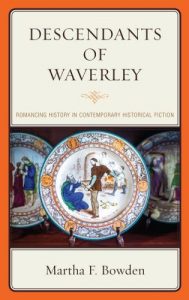
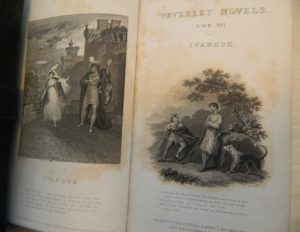
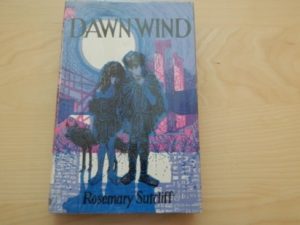 Writing this book was a great pleasure because it allowed me to investigate one of my favorite forms of fiction while employing my scholarly interest in the development of the novel. I realized that I have been reading historical fiction for most of my life; the first playground reading recommendation that I remember was from a classmate who loved Elizabeth Speare’s The Witch of Blackbird Pond. In the young adult fiction section I return to another early love, Rosemary Sutcliff, whose books I first discovered on those magical shelves of books at the back of my elementary and middle school classrooms. The Dawn Wind is the one I remember most clearly from those days; this book allowed me to discover more of her work. The good news is that, even after years of scholarly investigation, I still read historical fiction for pleasure.
Writing this book was a great pleasure because it allowed me to investigate one of my favorite forms of fiction while employing my scholarly interest in the development of the novel. I realized that I have been reading historical fiction for most of my life; the first playground reading recommendation that I remember was from a classmate who loved Elizabeth Speare’s The Witch of Blackbird Pond. In the young adult fiction section I return to another early love, Rosemary Sutcliff, whose books I first discovered on those magical shelves of books at the back of my elementary and middle school classrooms. The Dawn Wind is the one I remember most clearly from those days; this book allowed me to discover more of her work. The good news is that, even after years of scholarly investigation, I still read historical fiction for pleasure.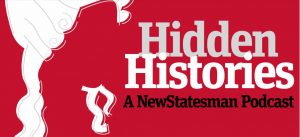 The Great Forgetting: Women Writers Before Austen
The Great Forgetting: Women Writers Before Austen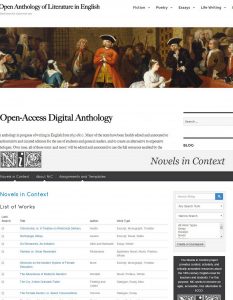 As any reader of The 18th-Century Common knows, the last quarter century has witnessed the astonishing digitization of thousands of texts from the past: novels, poems, essays, histories, plays, many of them available for free. For scholars, the creation of this Digital Republic of Learning has (on the whole) been a boon, enabling new modes of inquiry that could barely have been imagined a generation ago. For students, however, the digitization of the archive has been a more mixed blessing. As newcomers to the field, students can very easily find themselves overwhelmed by the sheer abundance of material that shows up in the simple Google search that is likely to be their first means of access. Students are unlikely to know how to judge of the quality or authenticity of what they find, or to be able to recognize the difference between a well-edited text and something with virtually no authority whatsoever. Texts are haphazardly distributed, some behind commercial paywalls such as
As any reader of The 18th-Century Common knows, the last quarter century has witnessed the astonishing digitization of thousands of texts from the past: novels, poems, essays, histories, plays, many of them available for free. For scholars, the creation of this Digital Republic of Learning has (on the whole) been a boon, enabling new modes of inquiry that could barely have been imagined a generation ago. For students, however, the digitization of the archive has been a more mixed blessing. As newcomers to the field, students can very easily find themselves overwhelmed by the sheer abundance of material that shows up in the simple Google search that is likely to be their first means of access. Students are unlikely to know how to judge of the quality or authenticity of what they find, or to be able to recognize the difference between a well-edited text and something with virtually no authority whatsoever. Texts are haphazardly distributed, some behind commercial paywalls such as 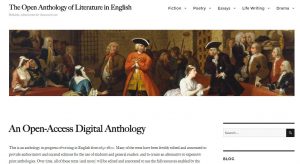 Our projects intend to improve the quality of eighteenth-century texts available for students, general readers, and scholars, and to enlist students in the project of producing them.
Our projects intend to improve the quality of eighteenth-century texts available for students, general readers, and scholars, and to enlist students in the project of producing them. 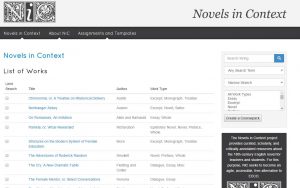 Novels in Context
Novels in Context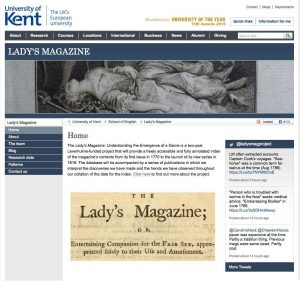 ‘
‘